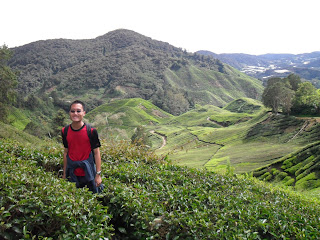

The Great Ocean Road, a windy, scenic, coastal road near Melbourne, is similar to California’s coastal Highway 1. Actually, with its numerous rock formations, curvaceous coast and blue-green water, I think the Great Ocean Road is more stunning than its California counterpart.
Four other CouchSurfers and I rented an SUV to explore the Great Ocean Road in two days. We started in Torquay (nearest to Melbourne) and drove all the way to Port Campbell before heading back. My favorite view of the Great Ocean Road meandering along the coast was at Teddy’s Lookout.
We camped at Cape Otway, the southernmost point of the area. Near our campsite were coastal trails that led to scenic, rocky beaches. Also, there were several koalas in the trees in Cape Otway, resting and eating, as usual. We also saw two koalas near the road at night while driving back.
Parts of the Great Ocean Road are a bit inland, giving us the opportunity to observe lush hills and valleys and cattle. Some areas reminded me of the European countryside.
The most stunning part of the Great Ocean Road had to be The Twelve Apostles and the area nearby. The Twelve Apostles are six (used to be twelve) rock formations in the ocean. Together with the adjacent undulating coast, it makes for great photographs and priceless memories. We were luckily able to witness the sunset and the changing colors of the clouds at The Twelve Apostles. Visiting nature’s gifts, like those along the Great Ocean Road, reminds me of how beautiful the world is and how we need to safeguard these natural treasures for future generations.
Four other CouchSurfers and I rented an SUV to explore the Great Ocean Road in two days. We started in Torquay (nearest to Melbourne) and drove all the way to Port Campbell before heading back. My favorite view of the Great Ocean Road meandering along the coast was at Teddy’s Lookout.
We camped at Cape Otway, the southernmost point of the area. Near our campsite were coastal trails that led to scenic, rocky beaches. Also, there were several koalas in the trees in Cape Otway, resting and eating, as usual. We also saw two koalas near the road at night while driving back.
Parts of the Great Ocean Road are a bit inland, giving us the opportunity to observe lush hills and valleys and cattle. Some areas reminded me of the European countryside.
The most stunning part of the Great Ocean Road had to be The Twelve Apostles and the area nearby. The Twelve Apostles are six (used to be twelve) rock formations in the ocean. Together with the adjacent undulating coast, it makes for great photographs and priceless memories. We were luckily able to witness the sunset and the changing colors of the clouds at The Twelve Apostles. Visiting nature’s gifts, like those along the Great Ocean Road, reminds me of how beautiful the world is and how we need to safeguard these natural treasures for future generations.

















